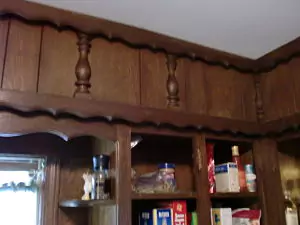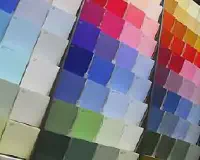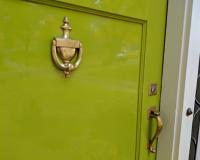Golden Oak cabinets are so last century. But re-staining or painting kitchen cabinets is not as straight-forward as painting your living room. Here's what to look for:

Material - there are trade-offs. Solvent-based (oil) materials have some advantages, but they have terrible odor. Not just your average terrible, but industrial strength, move out-of-your-house-for-three-days kind of terrible. A latex product solves the odor issue and the right product will solve the durability issue.
Application - there are some DIY kits available that say the product can be brushed on, but most professionals wouldn't even think of brushing kitchen cabinets. Cabinets require a silky-smooth, even layer of paint - the kind of finish that can only be achieved with a sprayer, a practiced hand and a keen eye.
 A close view of dated, dark and dingy cabinetry before painting. The previous homeowner was a heavy smoker - major cleaning was required.
A close view of dated, dark and dingy cabinetry before painting. The previous homeowner was a heavy smoker - major cleaning was required.Durability - This is a balance between finish hardness, flexibility and adhesion. Too hard and the finish will chip under the heavy use common to kitchens. Poor adhesion means it's even more likely to chip because it doesn't stick very well. Flexibility means the finish has more "give" when dinged but at a certain point adhesion comes into question. Proper material selection is critical - you don't want to learn six months later that there was a better choice available.
Blocking - A finish with good blocking properties will allow you to put a can of soup on the shelf and remove it a month later without leaving an impression or removing paint. Latex products have typically not had very good blocking properties, but there are niche materials available that block as well as oil-based paints.
Hardware - there's no problem to replace existing hinges or door pulls provided the hole spacing is the same. If there are holes to fill (say you change from a door pull to a knob), you might consider texture. The hole will be filled and then sanded smooth; that repair will not match the texture of the surrounding wood. Usually not a deal-breaker, but a small detail that might affect your expectations.
Interiors - Melamine cabinet interiors are almost always masked to protect from paint; wood or composite materials are often painted, depending on age, condition and homeowner preference. Masking takes more time to make sure that paint goes only where it should.
Grain-filling - Oak is considered an open grain wood and maple is a closed grain (and therefore very smooth) wood; other species may have knots. If the texture of open grain or knotty wood doesn't appeal to you the grain can be filled and sanded for a smoother appearance. This option involves a bit more time but it's a practical way to minimize wood texture. A caution, though - it's reasonable to expect a "disguise" of the wood grain rather than a complete conversion to piano-smooth.
If you'd like to discuss the options available for your kitchen cabinets or bathroom vanity, please call Crestwood Painting today!


